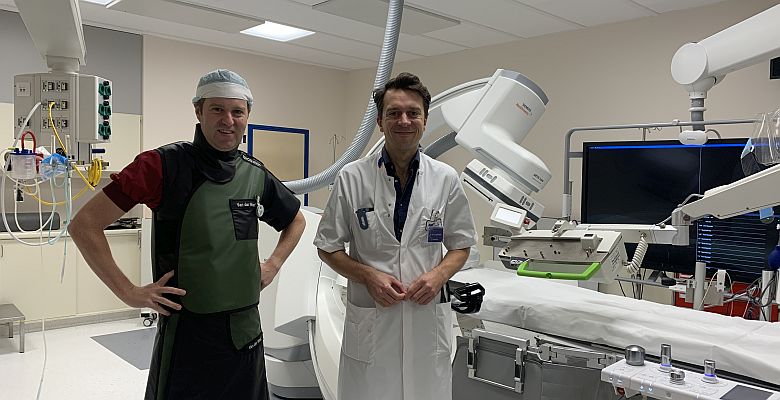At the Groningen University Medical Center (UMCG), patients can now be stented using a robotic arm. This is good news for both patient and cardiologist.
Robotic stenting is better for cardiologists as they receive far less X-ray radiation. The UMCG, connected to Groningen University in the northern part of the Netherlands, is the first hospital in the country to use this robotic arm for angioplasty. Interventional cardiologist Michael Dickinson (on right in picture) and his colleague Rik van der Werf recently started working with it – and they are enthusiastic.
Safer for patient
Stenting oping is opening or dilating a narrowing of one of the heart's blood vessels. This may be necessary very acutely, for example in the case of a heart attack, but also if the coronary arteries (the blood vessels around the heart) have been slowly narrowing for much longer.
To open or dilate a blood vessel, the interventional cardiologist inserts a stent into it. This is a short hollow tube a few millimetres in diameter. During stenting, the cardiologist inserts the stent at the site of the narrowing, so the vessel is open again and blood can flow unhindered.
With the robot, the stent can be placed with an accuracy of one-third of a millimetre. Every fraction of a millimetre is relevant, especially if the narrowing is in a bend or at a fork in the blood vessel. Technology has advanced considerably over the past few years, but there is always room for improvement. Stenting with a robotic arm is a big step forward.
Safer for cardiologist
Via a line in the wrist (or groin), the stent is brought to the heart, where the cardiologist slides the stent precisely into place under X-ray screening. The cardiologist normally stands right next to the patient, hence standing in the X-ray beam all day. Protective clothing such as a lead apron is literally leaden and can cause physical discomfort if worn all day. And even with protective clothing, a cardiologist receives about 7 to 8 µSV (microsievert) of radiation per procedure. That may not seem like much, as it is far less than the radiation a cardiologist is ex[posed to with one X-ray. But surgeons do this treatment several times a day, day in and day out.
With the new robotic arm, the cardiologist can stand behind a protective lead wall after inserting the line and control the robotic arm with three joysticks from there. The radiation that the cardiologist is then exposed to is zero, or at most 1 µSv per treatment. Wearing a heavy lead apron all day is no longer necessary.
Eye-hand coordination
The interventional cardiologist is used to standing next to the patient and looking at a large screen, while inserting the stent with his hands. Things are slightly different with the robotic arm, where the cardiologist operates the joysticks and his hands while looking at the screen.
"Still, it feels different," Dickinson says. "Normally we feel what we are doing with our fingertips; we miss that when we do it through the robot. But it wasn't too hard to learn, perhaps because we already have very good hand-eye coordination due to the regular working method in which we also look at the screen all the time. We did practice a lot in the skills centre first, though."
For the time being, emergency treatments are not yet eligible for robotic angioplasty, as it takes at least ten minutes to prepare the robot for use. In future, it is expected that more and more patients will be eligible for treatment with robotic arms. The cardiologists expect to have treated 100 patients with this new technology by next spring. This will be followed by an evaluation of the treatment's effect. Radiation exposure will also be closely monitored.
Photo: UMCG


